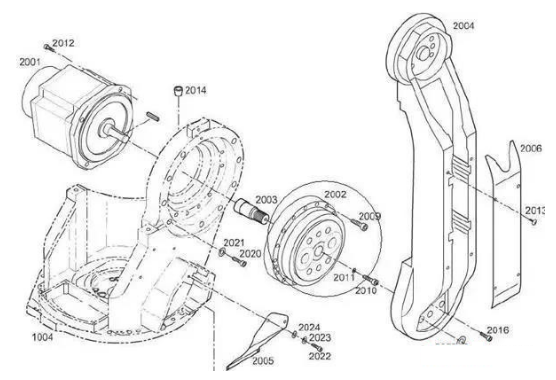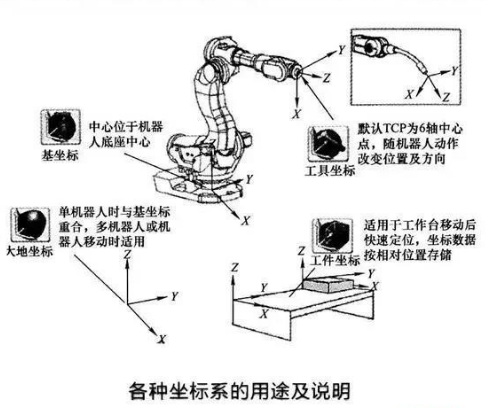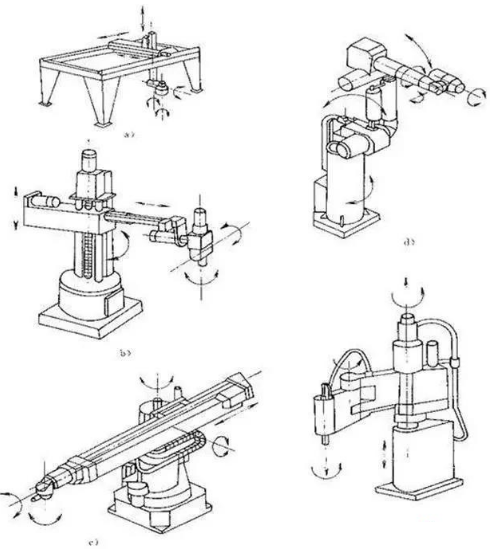Principles of robot control
Date:2019-09-30
System is an important part of industrial robots, and its function is equivalent to human brain. Having a well-functioned, sensitive and reliable control system is the key to coordinate the actions of industrial robots and equipment and accomplish the tasks together. The control system of industrial robots is generally composed of two parts: the control of its own motion and the coordinated control of industrial robots and peripheral equipment.
1. Characteristics of Industrial Robot Control System
The structure of the robot belongs to a spatial open-chain mechanism, in which the motion of each joint is independent. In order to achieve the trajectory of the end point, the motion coordination of multiple joints is needed. The control system of the robot is much more complex than that of the ordinary control system.
The characteristics of the robot control system are as follows:
(1) Robot control is closely related to the kinematics and dynamics of the mechanism. The state of the robot's hand and foot can be described in various coordinates. The reference coordinate system should be selected according to the specific needs and appropriate coordinate transformation should be made. The solutions of forward and reverse kinematics are often needed. In addition, the effects of inertia force, external force (including gravity) and centripetal force are also considered.
(2) Even a simpler robot needs at least 3-5 degrees of freedom, while a more complex robot needs more than a dozen or even dozens of degrees of freedom. Each degree of freedom generally contains a servo mechanism, which must be coordinated to form a multivariable control system.
(3) The computer can realize the coordinated control of multiple independent servo systems and make the robot act according to human's will, and even give the robot a certain "intelligent" task. Therefore, the robot control system must be a computer control system. At the same time, computer software undertakes arduous tasks.
(4) Because the state and motion of the robot are described by a non-linear mathematical model, its parameters change with the change of state and external force, and there is coupling among the variables. Therefore, it is not enough to use only position closed-loop, but also speed or even acceleration closed-loop. Gravity compensation, feedforward, decoupling or adaptive control are often used in the system.
(5) There is a problem of "optimum" because the action of robots can be accomplished in different ways and paths. For higher-level robots, artificial intelligence can be used to build a huge information base with the help of computers, which can be used for control, decision-making, management and operation.
According to the sensor and pattern recognition method, the working conditions of the object and environment are obtained, and the optimal control law is automatically selected according to the given index requirements. To sum up, the control system of robot is a multivariable control system which is closely related to kinematics and dynamics. Because of its particularity, classical control theory and modern control theory can not be copied. So far, the theory of robot control is not complete and systematic enough.
2. Main Functions of Industrial Robot Control System
The main task of industrial robot control system is to control the movement position, attitude and trajectory, operation sequence and action time of industrial robots in the workspace. Some of them are very complex. The main functions of industrial robot control system include the following two points:
(1) the function of teaching and reappearance. The function of teaching and playback refers to that the control system can teach the industrial robot by teaching box or hand handle, and teach the information of action sequence, movement speed, position and so on in a certain way in advance. The teaching operation process is automatically recorded in the memory by the memory device of the industrial robot, and the contents stored in the memory can be replayed when the reproduction operation is needed. If you need to change the operation content, just teach it again.
(2) Motion control function. Motion control function refers to the control of position, speed, acceleration and other items of industrial robot terminal manipulator.
3. Composition of Control System
The control system of industrial robot is composed of corresponding hardware and software.
(1) Hardware.
The hardware mainly includes the following parts:
1) Sensing device. It can be divided into internal sensors and external sensors. The former is used to perceive its own state, and its function is to detect the position, velocity and acceleration of the joints of industrial robots; the latter is used to detect the position, velocity and acceleration of the joints of industrial robots.
External sensors include vision, force, touch, hearing, sliding and so on.
2) Control devices. Generally, it consists of a micro or minicomputer and its corresponding interface. Its function is to process various sensory information, execute control software and generate control instructions.
3) Joint servo drive. The main function of this part is to drive the joint movement according to the requirements of the task, based on the instructions of the control device.
(2) Software.
The software mentioned here mainly refers to the control software of the robot. The control software consists of trajectory planning algorithm, joint servo control algorithm and corresponding action program. It can be programmed using all programming languages, but the mainstream of industrial robot control software is a special industrial language compiled by modularization of general language.
4. Name and function of each component of industrial robot control system
(1) Control computer. The control computer is the dispatching and commanding organ of the control system. It usually uses a micro-computer or a microprocessor. (2) Teaching boxes. The function of the teaching box is to complete the working trajectory, parameter setting and all human-computer interaction of the teaching robot. It has an independent CPU and storage unit, and communicates with the host computer by serial communication.
(3) Operating panel. The operation panel is composed of various operation keys and status indicators. Its function is to complete the basic function operation.
(4) Disk memory. Hard disk and floppy disk memory are equivalent to the memory used to store robotic programs.
(5) Digital and analog input/output. The function of this part is to realize the input or output functions of various states and control commands.
(6) Printer interface. The function of printer interface is to record all kinds of information that need to be output.
(7) Sensor interface. Sensor interface is used for automatic detection of information to achieve flexible control of robots, generally force, tactile and visual sensors.
(8) Shaft controller. The function of the axis controller is to control the position, velocity and acceleration of each joint of the robot.
(9) Auxiliary equipment control. Auxiliary equipment control is used to control and cooperate with robots, such as gripper transducer.
(10) Communication interface. Communication interface is used to exchange information between robots and other devices. Generally, there are serial interface, parallel interface and so on.
(11) Network interface. Network interface includes Ethernet interface and Fieldbus interface.
1) Ethernet interface. Direct PC communication between multiple or single robots can be realized through the Ethernet interface. The data transmission rate can reach 10Mb/s. After the application program is programmed directly on the PC with Windows 95 or Windows NT library function, the TCP/P communication protocol can be supported. The data and program can also be loaded into each robot controller through the Ethernet interface.
2) Fieldbus interface. Support a variety of popular field bus specifications, such as Device net, ABRemote I/O, Interbus-s, profibus-DP, M-NET, etc.

The structure of the robot belongs to a spatial open-chain mechanism, in which the motion of each joint is independent. In order to achieve the trajectory of the end point, the motion coordination of multiple joints is needed. The control system of the robot is much more complex than that of the ordinary control system.

The characteristics of the robot control system are as follows:
(1) Robot control is closely related to the kinematics and dynamics of the mechanism. The state of the robot's hand and foot can be described in various coordinates. The reference coordinate system should be selected according to the specific needs and appropriate coordinate transformation should be made. The solutions of forward and reverse kinematics are often needed. In addition, the effects of inertia force, external force (including gravity) and centripetal force are also considered.
(2) Even a simpler robot needs at least 3-5 degrees of freedom, while a more complex robot needs more than a dozen or even dozens of degrees of freedom. Each degree of freedom generally contains a servo mechanism, which must be coordinated to form a multivariable control system.

(3) The computer can realize the coordinated control of multiple independent servo systems and make the robot act according to human's will, and even give the robot a certain "intelligent" task. Therefore, the robot control system must be a computer control system. At the same time, computer software undertakes arduous tasks.
(4) Because the state and motion of the robot are described by a non-linear mathematical model, its parameters change with the change of state and external force, and there is coupling among the variables. Therefore, it is not enough to use only position closed-loop, but also speed or even acceleration closed-loop. Gravity compensation, feedforward, decoupling or adaptive control are often used in the system.

(5) There is a problem of "optimum" because the action of robots can be accomplished in different ways and paths. For higher-level robots, artificial intelligence can be used to build a huge information base with the help of computers, which can be used for control, decision-making, management and operation.
According to the sensor and pattern recognition method, the working conditions of the object and environment are obtained, and the optimal control law is automatically selected according to the given index requirements. To sum up, the control system of robot is a multivariable control system which is closely related to kinematics and dynamics. Because of its particularity, classical control theory and modern control theory can not be copied. So far, the theory of robot control is not complete and systematic enough.

2. Main Functions of Industrial Robot Control System
The main task of industrial robot control system is to control the movement position, attitude and trajectory, operation sequence and action time of industrial robots in the workspace. Some of them are very complex. The main functions of industrial robot control system include the following two points:

(1) the function of teaching and reappearance. The function of teaching and playback refers to that the control system can teach the industrial robot by teaching box or hand handle, and teach the information of action sequence, movement speed, position and so on in a certain way in advance. The teaching operation process is automatically recorded in the memory by the memory device of the industrial robot, and the contents stored in the memory can be replayed when the reproduction operation is needed. If you need to change the operation content, just teach it again.
(2) Motion control function. Motion control function refers to the control of position, speed, acceleration and other items of industrial robot terminal manipulator.
3. Composition of Control System
The control system of industrial robot is composed of corresponding hardware and software.
(1) Hardware.
The hardware mainly includes the following parts:
1) Sensing device. It can be divided into internal sensors and external sensors. The former is used to perceive its own state, and its function is to detect the position, velocity and acceleration of the joints of industrial robots; the latter is used to detect the position, velocity and acceleration of the joints of industrial robots.
External sensors include vision, force, touch, hearing, sliding and so on.

2) Control devices. Generally, it consists of a micro or minicomputer and its corresponding interface. Its function is to process various sensory information, execute control software and generate control instructions.
3) Joint servo drive. The main function of this part is to drive the joint movement according to the requirements of the task, based on the instructions of the control device.
(2) Software.
The software mentioned here mainly refers to the control software of the robot. The control software consists of trajectory planning algorithm, joint servo control algorithm and corresponding action program. It can be programmed using all programming languages, but the mainstream of industrial robot control software is a special industrial language compiled by modularization of general language.
4. Name and function of each component of industrial robot control system
(1) Control computer. The control computer is the dispatching and commanding organ of the control system. It usually uses a micro-computer or a microprocessor. (2) Teaching boxes. The function of the teaching box is to complete the working trajectory, parameter setting and all human-computer interaction of the teaching robot. It has an independent CPU and storage unit, and communicates with the host computer by serial communication.
(3) Operating panel. The operation panel is composed of various operation keys and status indicators. Its function is to complete the basic function operation.
(4) Disk memory. Hard disk and floppy disk memory are equivalent to the memory used to store robotic programs.
(5) Digital and analog input/output. The function of this part is to realize the input or output functions of various states and control commands.
(6) Printer interface. The function of printer interface is to record all kinds of information that need to be output.
(7) Sensor interface. Sensor interface is used for automatic detection of information to achieve flexible control of robots, generally force, tactile and visual sensors.
(8) Shaft controller. The function of the axis controller is to control the position, velocity and acceleration of each joint of the robot.
(9) Auxiliary equipment control. Auxiliary equipment control is used to control and cooperate with robots, such as gripper transducer.
(10) Communication interface. Communication interface is used to exchange information between robots and other devices. Generally, there are serial interface, parallel interface and so on.
(11) Network interface. Network interface includes Ethernet interface and Fieldbus interface.
1) Ethernet interface. Direct PC communication between multiple or single robots can be realized through the Ethernet interface. The data transmission rate can reach 10Mb/s. After the application program is programmed directly on the PC with Windows 95 or Windows NT library function, the TCP/P communication protocol can be supported. The data and program can also be loaded into each robot controller through the Ethernet interface.
2) Fieldbus interface. Support a variety of popular field bus specifications, such as Device net, ABRemote I/O, Interbus-s, profibus-DP, M-NET, etc.